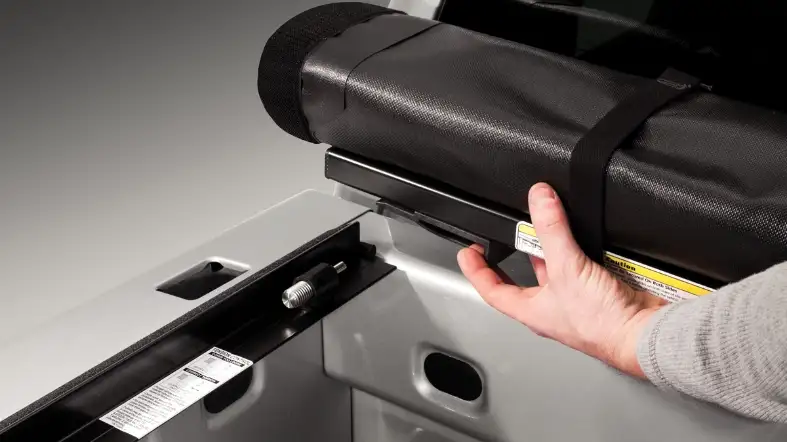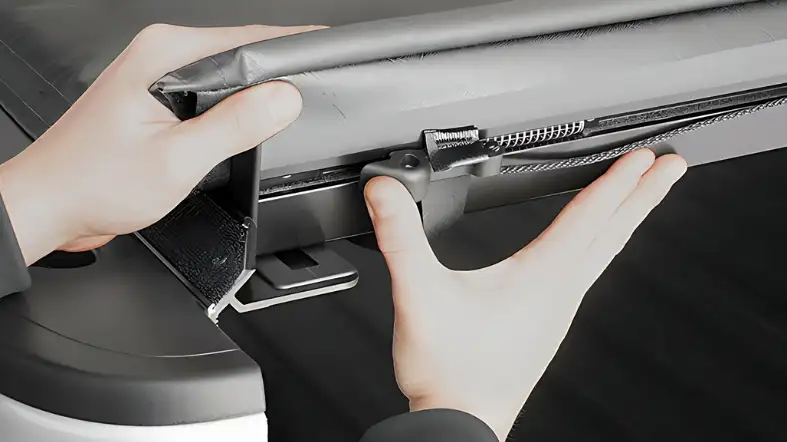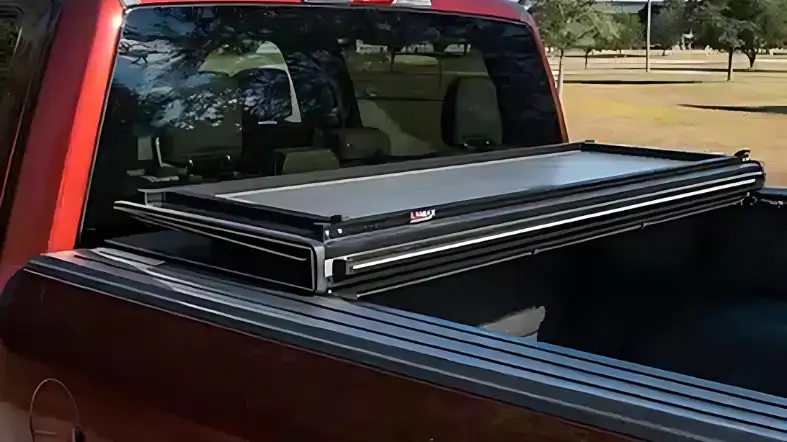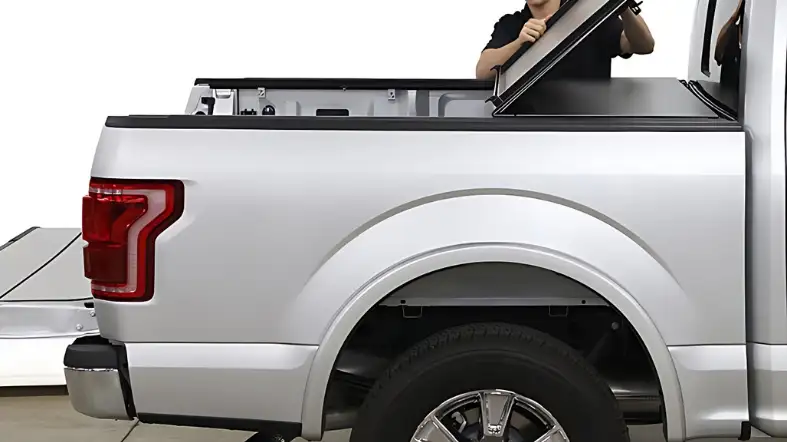Are you frustrated with a loose, heavy and flimsy tonneau cover? The key to a secure and snug fit lies in knowing how to tighten it effectively.
But how do you tighten a tonneau cover without compromising its functionality?
In this article, we unravel the mystery and share expert tips to achieve the perfect tension.

How Do You Tighten A Tonneau Cover?
Here is how you can tighten a tonneau cover:
Adjust the Clamps
Start by locating the clamps that secure the tonneau cover to the truck bed. These clamps are typically positioned on the sides near the rear end.
Loosen the clamps and reposition them closer to the truck bed if there is excessive slack in the cover.
Once repositioned, tighten the clamps securely to ensure a snug fit.
Check the Latches
Inspect the latches that hold the tonneau cover in place when it’s closed. If the latches are loose or misaligned, the cover may not be taut.
Adjust the latches as needed, tightening them securely so they firmly engage when closing the cover.
Tighten the Velcro Strips
Many tonneau covers feature Velcro strips along the sides and edges. Over time, these strips may lose their adhesive strength, resulting in a loose cover.
To tighten the cover, press firmly on the Velcro strips to ensure they adhere tightly to the truck bed.
If the strips are worn or damaged, consider replacing them for optimal performance.
Use Tension Adjusters
Some tonneau covers come with tension adjusters, which allow you to fine-tune the tightness of the cover.
Locate the tension adjusters, typically positioned near the rear end of the cover.
Turn the adjusters clockwise to increase tension and counterclockwise to decrease tension.
Experiment with different settings until you achieve the desired level of tightness.
Install Support Bows
Certain tonneau covers, such as folding or roll-up types, utilize support bows to maintain tension.
If your cover includes support bows, ensure they are correctly positioned and securely fastened.
These bows provide additional support, preventing sagging and maintaining a tight fit.
Check for Loose Fasteners

Inspect all fasteners, such as bolts, nuts, or screws, that secure the tonneau cover components together.
Over time, these fasteners may loosen due to vibrations or frequent use. Tighten any loose fasteners using the appropriate tools, ensuring all connections are secure.
Weatherstripping Maintenance
Weatherstripping plays a crucial role in sealing the tonneau cover and preventing water or dust from entering the truck bed.
Regularly inspect the condition of the weatherstripping and ensure it is intact and properly aligned.
If the weatherstripping is damaged or misaligned, replace or readjust it to maintain an airtight seal.
Utilize Bed Extenders
If you have a truck bed extender, you can utilize it to tighten the tonneau cover and beak into it.
Extend the bed extender fully and place it against the cover’s rear end. This helps create tension, reducing any sagging or looseness.
Add Reinforcement Clamps
Some tonneau covers allow for additional reinforcement clamps to be installed. These clamps provide extra support and help maintain a tight fit.
Consult the manufacturer’s instructions to determine if your cover is compatible with reinforcement clamps, and if so, follow the installation guidelines.
Different Types of Tonneau Covers and How to Tighten Them
Here are the different types of tonneau covers and how to tighten them
Roll-Up Tonneau Covers
To tighten a roll-up tonneau cover, start by unrolling it completely and secure the end by latching it into place.
Then, move to the center and adjust the tension control knobs or straps according to the manufacturer’s instructions.
Gradually tighten the cover, making sure it is evenly distributed along the truck bed. Finally, check the tightness and make any necessary adjustments.
Folding Tonneau Covers

When tightening a folding tonneau cover, unfold the panels completely and ensure they are aligned properly.
Many folding covers have integrated clamps or latches on the side rails. Use these clamps to secure the panels tightly.
Adjust the tension by tightening the clamps evenly on both sides. Confirm that the cover is snug and secure before closing the tailgate.
Retractable Tonneau Covers
Retractable covers usually have a built-in tensioning system. To tighten the cover, extend it fully and lock it in place.
Then, locate the tension adjuster knobs or levers and turn them clockwise to increase tension.
Make sure to adjust both sides equally for balanced tightness. Test the cover’s tightness by gently pushing on it to ensure it stays securely in position.
Hinged Tonneau Covers
Hinged covers typically have a locking mechanism on the rear or side of the cover.
Start by opening the cover fully and engaging the locking mechanism. Some hinged covers may have built-in tension adjusters or rods.
Follow the manufacturer’s instructions to adjust the tension using these features. Check the tightness by gently pressing on the cover to ensure it remains stable.
Snap-On Tonneau Covers
For snap-on covers, start by fastening the snaps along the side rails, beginning from the cab end and working your way toward the tailgate.
Make sure the snaps are evenly spaced and secured tightly.
To tighten the cover, apply pressure along the center and push downwards, which will help stretch the cover and create a tighter fit. Verify that all snaps are securely fastened.
Common Mistakes to Avoid When Tightening a Tonneau Cover
Here are the common mistakes to avoid when tightening a tonneau cover
Over-Tightening
Avoid the mistake of over-tightening your tonneau cover. Applying excessive force or tension can strain the cover, leading to potential damage or warping. .
Follow the manufacturer’s recommended tension guidelines and avoid overtightening beyond those specifications.
This ensures a secure fit without putting unnecessary stress on the cover and its components.
Uneven Tension
Make sure to distribute the tension evenly across the tonneau cover.
Uneven tension can cause the cover to fit improperly or create gaps that may compromise its functionality and weather resistance.
Check that the tension is balanced on both sides of the cover and adjust accordingly to achieve a consistent and snug fit.
Ignoring the Manufacturer’s Instructions
One of the most common mistakes is disregarding the specific instructions provided by the manufacturer.
Each tonneau cover may have unique tightening methods and recommendations.
Take the time to thoroughly read and understand the instructions before attempting to tighten the cover.
This will help you avoid errors and ensure you’re following the correct procedure.
Neglecting Regular Maintenance
Failure to maintain your tonneau cover can result in poor tightening performance.
Over time, debris, dust, and grime can accumulate on the cover, affecting its flexibility and ability to secure tightly.
Regularly clean and inspect the cover, removing any debris or buildup.
Additionally, lubricate hinges, clamps, or tensioning mechanisms as recommended by the manufacturer for smooth operation.
Rushing the Tightening Process
Patience is key when tightening a tonneau cover. Rushing the process can lead to mistakes and improper fitment.
Take the time to carefully follow the steps provided by the manufacturer, ensuring each adjustment is made correctly.
Double-check the tension and overall fit of the cover before considering the job complete.
Tonneau Cover Maintenance Tips for Long-Lasting Tightness

Here are some tonneau cover maintenance tips for long-lasting tightness:
Regular Cleaning
Keep your tonneau cover clean to maintain its tightness. Use a mild soap or cleaner and a soft brush or cloth to remove dirt, debris, and stains. Avoid harsh chemicals that could damage the cover material.
Thoroughly rinse and dry the cover before closing it to prevent moisture buildup.
Lubrication of Moving Parts
Periodically lubricate the moving parts of your tonneau cover to ensure smooth operation and tightness.
Apply a silicone-based lubricant to hinges, latches, and tensioning mechanisms as recommended by the manufacturer.
This helps prevent stiffness, rust, and friction, allowing for proper tightening and easy opening and closing.
Check for Loose Hardware
Regularly inspect the hardware of your tonneau covers, such as clamps, bolts, and screws, to ensure they are secure. Over time, vibrations and usage can cause them to loosen.
Tighten any loose hardware using the appropriate tools, being careful not to overtighten and risk damaging the cover or components.
Adjust Tension as Needed
Monitor the tension of your tonneau cover regularly and make adjustments as necessary.
Over time, changes in temperature and weather conditions can affect the cover’s tightness.
Follow the manufacturer’s instructions to adjust the tension, whether it’s through tension control knobs, straps, or other mechanisms, to maintain an optimal fit.
Protect from Harsh Weather
Extreme weather conditions can impact the tightness and longevity of your tonneau cover.
In harsh sunlight, use a UV protectant spray to prevent fading and deterioration of the cover material.
During winter or heavy rain, ensure that the cover is properly sealed and water-resistant to prevent leaks and maintain tightness.
Avoid Overloading
Overloading your tonneau cover can strain its tightening mechanisms and compromise its effectiveness.
Respect the weight limits specified by the manufacturer and distribute the load evenly across the cover.
By avoiding excessive weight, you can help maintain the cover’s integrity and tightness over time.
Frequently Asked Questions
Can I Tighten A Tonneau Cover Without Any Special Tools?
Most tonneau covers can be tightened using simple hand tools like a wrench or screwdriver.
What Is The Best Method To Tighten A Roll-Up Tonneau Cover?
For roll-up tonneau covers, adjusting the tension control system or tightening the Velcro strips along the sides is typically the most effective method.
Are There Specific Instructions For Tightening A Folding Tonneau Cover?
Folding tonneau covers often have built-in clamps or tension adjusters that allow for easy tightening.
Follow the manufacturer’s instructions for your specific model.
How Tight Should The Tonneau Cover Be?
The tonneau cover should be tight enough to prevent flapping or sagging but not overly tight to the point of putting excessive strain on the cover or its components.
What Should I Do If My Tonneau Cover Keeps Coming Loose?
If your tonneau cover keeps coming loose, double-check the clamps, latches, and tension adjusters to ensure they are properly secured. Consider replacing worn-out or damaged components.
Can I Adjust The Tonneau Cover Tension By Myself, Or Do I Need Professional Assistance?
In most cases, you can adjust the tonneau cover tension by yourself using the provided instructions.
However, if you encounter difficulties or have concerns, it is advisable to seek professional assistance.
Final Words
You’re now equipped with the know-how to tighten your tonneau cover like a pro.
By following these maintenance tips and techniques, you can achieve a secure and snug fit that will keep your truck bed protected and your cargo safe.
Remember to regularly clean, lubricate, and inspect your cover, making necessary adjustments to maintain optimal tightness.
